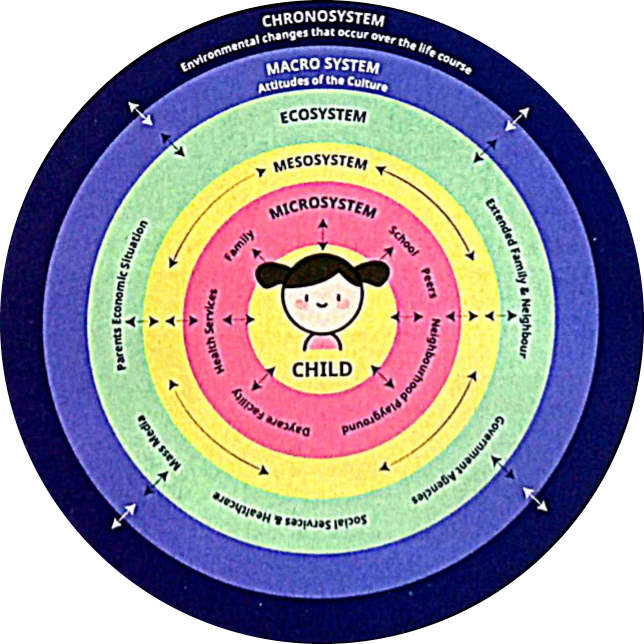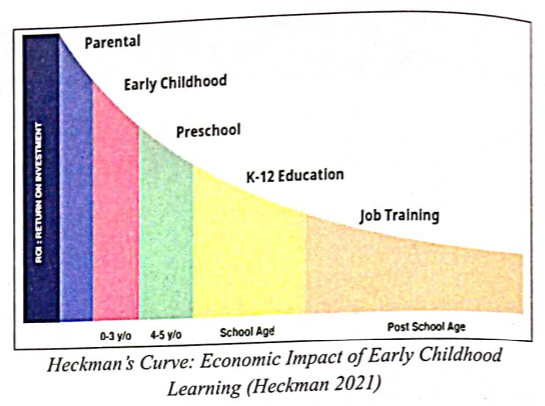ForumIAS announcing GS Foundation Program for UPSC CSE 2025-26 from 19 April. Click Here for more information.
Contents
- 1 Introduction
- 2 What is Early Childhood Care and Education (ECCE)?
- 3 What are the three fundamental requirements for Early Childhood Care and Education?
- 4 What is the need for Early Childhood Care and Education?
- 5 What is the status of Early Childhood Care and Education (ECCE) in India?
- 6 What are the challenges in improving ECCE?
- 7 What steps can be taken to improve ECCE?
| For 7PM Editorial Archives click HERE → |
Introduction
At present, there are about 100 million children between the ages of 3-6 years. These years are the bridge years between home and school and are critical for the physical, cognitive, socio-emotional, language, and early numeracy development. These components together comprise Early Childhood Care and Education (ECCE).
These years have the ‘most important influence in subsequent learning, behaviour and health’. The devastation caused by the lack of early learning for the majority of little children due to the pandemic presents one of the biggest challenge today. There is a need to expand the opportunities to the youngest children of India, as the future depends on how India’s youngest children are empowered to learn and craft their own future in a fast-paced, ever-changing world.
What is Early Childhood Care and Education (ECCE)?
According to UNESCO, Early childhood is defined as the period from birth to eight years of age. It is a time of remarkable growth with the brain development at its peak.
Early Childhood Care and Education (ECCE) is more than preparation for primary school. It aims at the holistic development of a child’s social, emotional, cognitive and physical needs in order to build a solid and broad foundation for lifelong learning and wellbeing.
| Read more: The need to reopen anganwadis |
What are the three fundamental requirements for Early Childhood Care and Education?
For overall development, a child in the early years needs (a) Care, in the form of good health & nutrition and a safe environment; (b) Stimulation that fosters curiosity particularly ‘planned play, adult-child interactions, child-child interactions, and opportunities for holistic development’.
Children begin to form a sense of self, but their agency is mediated by caring adults who surround them-—family, teachers, anganwadi workers, etc. They play with their peers in the community. That’s why there is an adage, “It takes a village to raise a child.”
What is the need for Early Childhood Care and Education?

Foundation of future: Over the next decade, about 23-24 million births are expected per year. If India does the heavy lifting of educating this one generation, future generations will reap rich dividends.
According to National Education Policy(NEP) 2020, “Over 85% of a child’s cumulative brain development occurs prior to the age of 6, indicating the critical importance of appropriate care and stimulation of the brain in the early years.

Disproportionately Higher Returns: Nobel Laureate James Heckman strongly argues that investing in early childhood education produces the greatest returns in terms of human capital and ensures quality economic returns. It results in far greater returns than the same investment in schooling.
Key for optimal living: Neuroscience tells that ‘a young child’s brain develops through stimulation of the sensing pathways (e.g. seeing, hearing, touching, smelling, tasting) from early experiences’. The child’s brain in the early years is like plastic, rapidly growing, and yearning for experiences to prepare itself for the future.
The greater the number of experiences, the more neural pathways are created by neurons for optimal learning and development. Early experiences profoundly impact the prefrontal cortex part of brain which plays a vital role in executive skills like the ability to think clearly, self regulate, manage time, organise self, be goal-directed or in short – the key ingredients for optimal living.
Therefore, missing this critical window of opportunity would be to deprive the child of an opportunity for learning and a better future.
Children learn all the time: Children learn from anything and everything they see. They learn from wherever they are, not just in special learning places like schools, anganwadis.
Enhance multilingualism: Researchers have shown that children pick up languages extremely quickly between the ages of 2 and 8 and that multilingualism has great cognitive benefits to young students.
| Read more: Need of Early Child Development |
What is the status of Early Childhood Care and Education (ECCE) in India?

The NEP 2020 has taken a big step in making ECCE a core Policy imperative: “Universal provisioning of quality early childhood development, care, and education must … be achieved as soon as possible, and no later than 2030, to ensure that all students entering Grade I are school ready.”
National Initiative for Proficiency in Reading with Understanding and Numeracy (NIPUN Bharat): The initiative aims to ensure every child in the country attains Foundational Literacy and Numeracy (FLN) at Grade 3 by 2026-27.
The Ministry of Education’s ‘Guidelines for Parent Participation in Home Learning’ mention a key strategy for early learning, that is to ‘turn everyday routines into fun playful moments for learning and brain development’. The Guidelines provide an A-Z listing of moments and activities that can be conducted e.g., the connect with nature guideline: Encourage children to observe the flowers, trees, plants, leaves, birds, butterflies, insects in the local environment.
Among other programmes, India has one of the largest networks of child care or Anganwadi centres. These centres have been set up under the Ministry of Women & Child Development’s Integrated Child Development Services (ICDS) Scheme (1975), which provides a range of services, from health and nutrition to pre-school non-formal education.
In addition, private preschool, and daycare services have been accessible at various price points due to increased demand particularly between 2008 and 2020.
Role of Civil society organisations: CSOs have played a significant role in conducting pioneering research, working extensively with States in building capacity for anganwadis and schools, spreading awareness, implementing programmes, and interventions and creating a number of practitioner resources.
These initiatives have generated a buzz in the ecosystem to create an impact in the ECCE space and maximise opportunities for every child’s future in India.
| Read more: The significance of ECCE and how Anganwadis can be instrumental in delivering it |
What are the challenges in improving ECCE?

Children are not school ready: Of the nearly 25 million children born in India every year, about 99% enrol in school at the age of 5 or 6. However, as the report ASER 2019: ‘Early Years‘ reveals, many children enter school without being school-ready. Only 10.7% of children aged 5 could match pictures beginning with the same sound, and only 17.5% could complete a simple pictorial pattern.
Lack of quality: Despite multiple actors and a variety of interventions and initiatives, achieving quality ECCE still remains a challenge. According to the NEP 2020, ‘Presently, quality ECCE is not available to crores of young children, particularly children from socio-economically disadvantaged backgrounds’.
Neglect from parents/caregivers: The current parent/caregiver mindset is ‘Early years are the days for play’. NIPUN Bharat observes that one present barrier is that the parents/caregivers do no have a role to play in education if they themselves are illiterate and their role ends at sending the child to school.
| Read more: Anganwadis should provide early childhood care and education |
What steps can be taken to improve ECCE?
Empower adults: There is a need to empower caring adults to engage in child’s early age learning. This can be done by (a) Creating access to local language resources, (b) Aligning learning outcomes for preschoolers with Ministry of Education guidelines, (c) Creating a National caregiver helpline where caring adults can get complete guidance in their local language, (d) Creating a platform that offers everything about “Early Learning” — from curriculums, resources, including books, toys, word activities and word games, etc.
Further, It has been found that male caregivers report higher levels of overall satisfaction compared with female caregivers’, thus opening up an opportunity for planned interventions to involve fathers/male caregivers.
Implement the strategy mentioned in NIPUN Bharat: The programme proposes that change should be brought through campaigns, events, etc., drawing on key insights from successful public programmes like Polio eradication and Swachh Bharat in order to make ECCE a Jan Andolan or People’s movement.’
Convert the technology Divide to Dividend: ASER Report 2021 mentions that during the Covid-19 lockdown the availability of smartphones has almost doubled from 2018-2021. This signals a critical shift in parental mindset about the use of smartphones for learning.
Hence, technology in the ECCE space is not child facing, but can become a powerful tool to empower and enable caring adults to raise the quality of interactions with their children in the physical world.
Turning the multilingual classroom into a resource rather than a barrier: The UNICEF-LLF ‘Guidelines for Implementation of Early Learning Programs’ mentions that including children’s local language helps to promote ‘an equitable learning environment’, ‘a strong platform for learning the school language’, and ‘higher-order work like thinking, reasoning and expression’.
So, the government can fast track the recommendations of the NEP, such as generation of textbooks, Teacher Learning Materials, and ‘enjoyable and inspirational books’ in local languages.
Make ECCE inclusive: The NEP 2020 specifically calls out that ‘children who come from families that are economically disadvantaged’ reap the ‘greatest dividends’ with early childhood education. This can be done by (a) Inclusion of all Socio Economically Disadvantaged Groups (SEDGs) at the three levels of access, participation, and learning outcomes; (b) Certain geographical areas contain significantly larger proportions of SEDGs. These areas should be declared Special Education Zones (SEZs) where all the schemes and policies are implemented to the maximum; (c) Specially targeting girls, who cut across all underrepresented groups; (d) Ensuring inclusion and equal participation of children with disabilities in ECCE.
Despite the setback due to the pandemic, with the trend of children now returning to schools, India needs to expand the opportunities to the youngest children of India. Policy intent exists, what is now required is an ecosystem to create, contribute, and leverage building blocks required to create diverse solutions and resources for the sake of ECCE.




